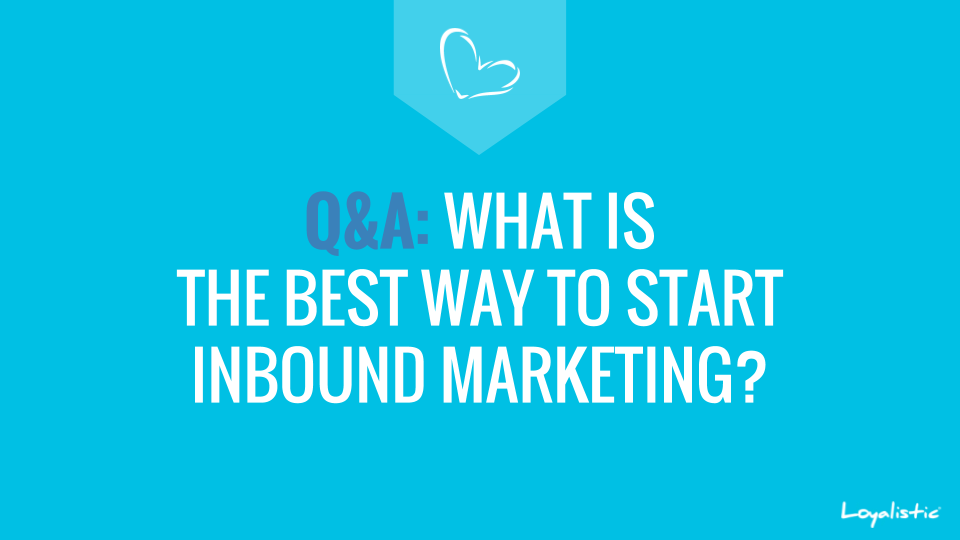
I have recently trained and workshopped hundreds of businesses, and speak to thousands at different events about inbound, and one question keep popping up in various formats: “What is the best way to start inbound marketing, sales or lead generation operation and succeed?”
Every business is different, so instead of giving ‘one size’ answer that doesn’t fit anyone, I’ll give you few advices and approaches that have worked well for our clients who tend to be smaller, b2b professional services or technology businesses.
The surpising thing I have learned is that the approach most inbound consultants recommend, seems to be the surest way to stall the progress in these companies. What works for enterprise rank-and-files, does not work at all with more agile smaller expert teams.
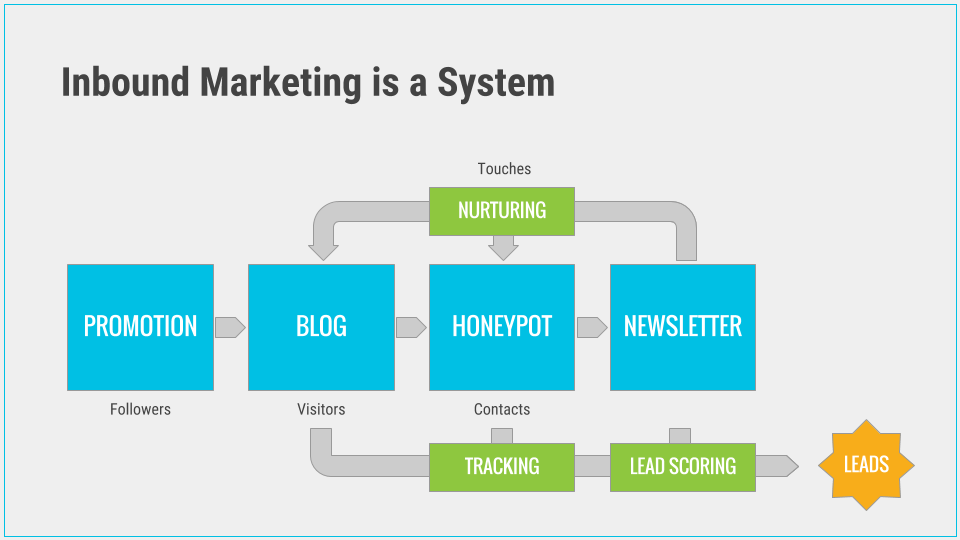
Inbound Marketing is a System
Content marketing, especially if you are doing it to get inbound leads, is actually quite complicated system. It requires many cogs to get the system pumping leads from the internet. If you are lacking a vital cog, no leads get pumped out. Some cogs are optional and beneficial for better results.
Think each cog as a separate skill to master. Take content promotion to social media as an example. Or search engine optimization (SEO). Now think you are learning juggling. Obviously you don’t start juggling with swords, torches or motor saws for god sakes! You start with one ball. Then you add another. And another. And when you finally can juggle with many balls with eyes closed, you may try to switch balls to something a bit more dangerous. Yet for some reason many businesses think they should immediatelly start with 7 swords!
A inbound marketing system contains the following sub operations or cogs. As you cannot realistically build all up at once, you need to start what suits you best, and where you can leverage what you have and get some early success.
Content Promotion: You need to drive traffic to your content with paid or non-paid organic content promotion from social media, search engines, media and blogs.
Blog: Blog is often the hub where you attract traffic. It is often a content promotion channel itself promoting ebooks, webinars etc.
Honeypot: To capture contact information, you need valuable content such as ebook as bait, a form and often a landing page. This is called a honeypot and you are capturing contacts, which are marketing leads.
Newsletter: Traffic is hard to get, so you want to get audience coming back. You promote your new content to your contacts with newsletters.
Nurturing: Newsletter, campaigns and especially automated emails nurture contacts to come back, read more, move forward…
Lead Tracking: When every visit, page view and email is tracked, you know how contacts are progressing.
Lead Scoring: Each activity is scored so leads can be ordered from most likely to buy first.
Leads: The outcome of this operation is leads that are worth selling to, that is qualified accepted leads that have shown interest, are active, trusts you and have accepted your expertise.
Forget best practice, strategy, buyer personas… Start learning by doing.
As a domain expert you need to stay on top of your game and rely on industry best practices. But content marketing is not your game. Leave content marketing best practice to content marketing consultants for now. Instead of the right way, select the practical way. Learn by doing. Some basics are good to know, but one more ebook, webinar, seminar or strategy session won’t make things any easier, it will make things more complicated.
You don’t need a content strategy. You don’t need to define your buyer personas. You don’t need a consultant to get started.
You are entering content competition, and it’s way different from the competition you are used to. No strategy will guide you thru unknown if it is based on wrong hypothesis.
Let’s face it, you as a person or team are lacking many skills of a content marketer, but domain expertise is not one of those. You are a true expert of your domain. You might not be the best writer or speaker, but no professional content marketer can replace you as the best expert in your field. Start from what you know best, and develop style as you go.
Approach #1: Start weekly blog
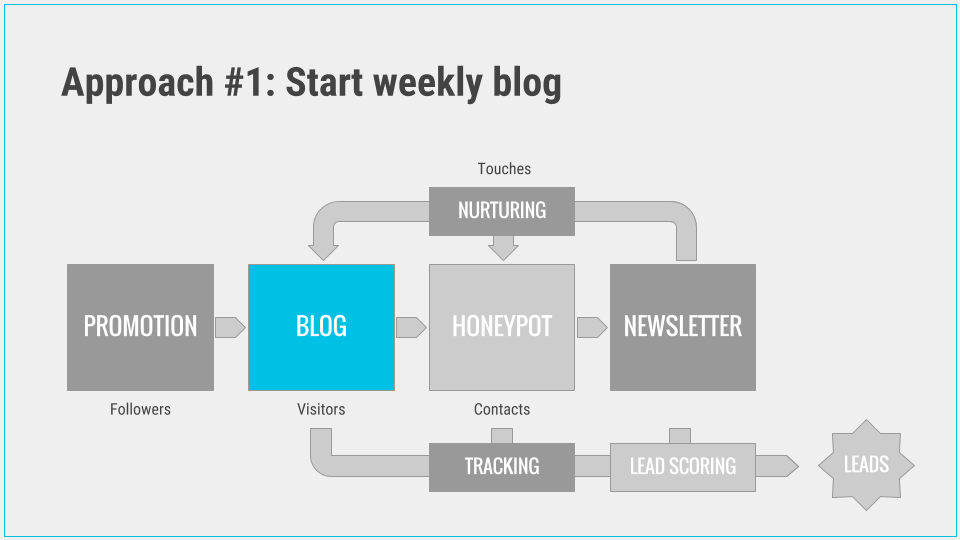
Blogging is one good approach to start. When you start, you don’t have much of an audience, but then you are just learning to write interestingly. While you keep going, you get better and your audience grows with you.
Blogging on the other hand is not inbound as such. Why? Because it does not have a conversion mechanism. If your potential audience is not huge (in b2b terms), blogging is not a lead generation tactic without a honeypot. But it is great for building relationships, take your position as a true expert and make selling a whole lot easier.
Few tips though:
Aim for weekly schedule. It’s easiest to keep going after hiccups. Put it to your weekly schedule, reserve e.g. monday morning for writing or friday lunchtime for publishing. If you held a weekly meeting with your team, put it as a fixed item on the agenda. But don’t sweat if you have miss a weekly post. The beauty of the weekly schedule is that you have another slot reserved for next week to get back on track. But if you aim for biweekly or looser schedule, it is far more likely you will skip one post, then another and then you notice that couple of months have passed with no posting, and you are back on square one trying to start the whole operation once again.
Answer questions. You and your team work with clients every day. And clients ask questions. Answer them with blog posts. That’s your content strategy.
If your domain is crowded with content and blood, you need find a space where the sea is blue. You may want to read how a small New Jersey -based SaaS-startup Groove build 5 Million dollar a year business in 3 years, and how they found their blue ocean. Once they did, they just keep answering people’s questions with blog posts to success.
How long will it take to get started? Setting up a blog is done in less than an hour including branding it. Writing a post usually 2 hours. But as always, you can spend countless hours procrastinating, that is, planning, researching, rewriting...
The next step? Once you get traction with your blog, you should expand to email strategy with either subscribe newsletter call-to-action which is quite weak, add a honeypot with ebook or similar as a bait, which works lot better.
Approach #2: Honeypot project with paid promotion
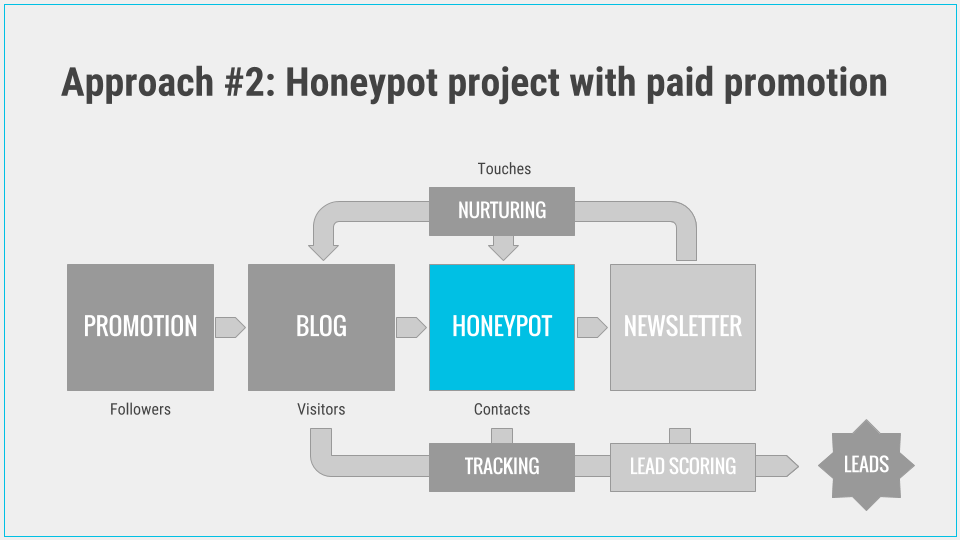
Honeypot is a piece of valuable content and a landing page with a lead capture form. In order to get the content, a client must fill the form and give you her email address and some other details.
This approach generates leads, although the problem is often traffic, or lack of it. So you need to pay to drive traffic.
Create an ebook, webinar or any other 19 best content for lead capture. Create the honeypot a k a create landing page with a form, upload your ebook as a bait.
Advertise your honeypot with Facebook, Twitter, LinkedIn, Google Adwords, banner ads or whatever works best in your market and audience.
Add an automated email nurture program, that is create a series of emails send to clients e.g. 1 day, 3 days, 7 days after they download your ebook, watch your webinar or try your product.
Remember to add lead tracking script to your website to track leads when they visit your website and score leads for sales.
Write a guide. For new business, a guide to your domain is usually the best approach. When people are searching information, your competition usually targets them to raise interest or to capture those searching for vendor. Yet general information search phase is often neglected. That is your opportunity. Teach them the ropes. Writing is a guide is actually quite easy. How would you brief a new hire coming outside your trade. Start writing what you would say. Write until you run out of points. Let it rest a week. Edit. Add bit of styling and images. Save as PDF. Done!
The problem of this approach is two fold. You don’t have traffic so you need to buy it with paid methods. The risk is that you end up writing something that interest you and just push that to people’s faces with money. This is usually the pitfall a marketer takes when she doesn’t get content part of the content marketing. Over time your bait looses traction. If you fail to start building organic traffic with content and non-paid social media, you easily end up throwing more money promoting a sinking piece of content, instead of putting effort to get your own content creation systematic.
How long will it take to get started? Writing an ebook takes typically 1-2 days (1 day first draft, 4 h edit, 4 h designing) + 1 h for all the rest.
The next steps? If you have written a guide or ebook, consider publishing each chapter as a blog post to promote the landing page. Continue to blogging.
Approach #3: Newsletter for customers
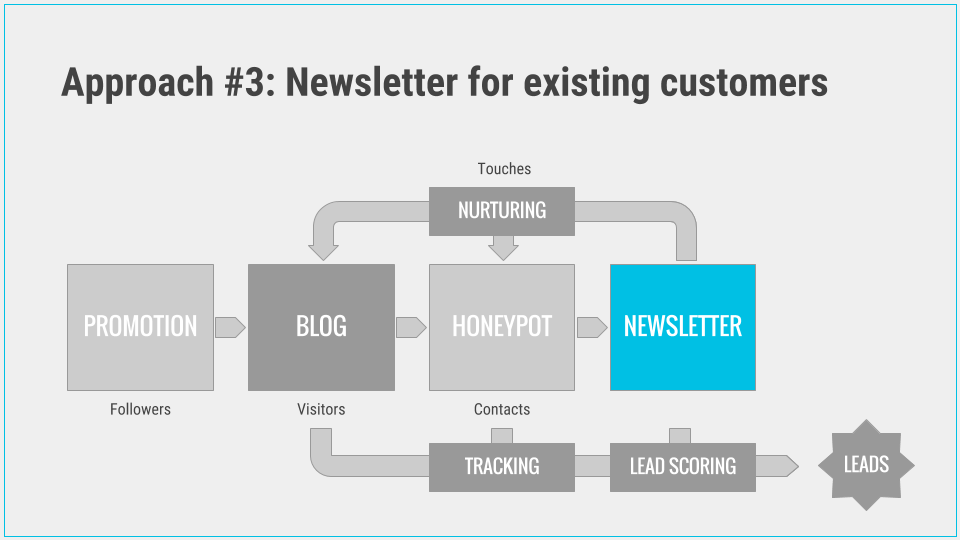
If you have customers, you have communication needs towards them usually regardless of how busy you are. You know that if you don’t do anything to keep your customers up-to-date, you soon don’t have any customers to keep up-to-date. Luckily this is one great path to content marketing.
Start with a newsletter, but with a twist: Create each piece of content as a blog post or landing page first. Then drag-and-drop that content to the newsletter.
What happens here is that you actually set up a blog and start newsletter at the same time with the effort of one.
In the beginning you are writing to your existing customers about subjects that you want to tell, but hopefully over time you notice that content that interest them works better than content that you want to write. As you are actually blogging, you start building audience.
And at some point you expand your newsletter from existing customers to those in your new business sales pipeline. Pushing you to make the content again bit more interesting and putting more emphasis to content in the content marketing.
You start from existing customers but expand who you write bit by bit from customers to prospects to leads… And suddenly inbound starts to happen.
How long will it take to get started? Typically 2 hours including writing the content.
The next steps? This approach leads to blogging and email marketing. But it is lacking a lead capture mechanism, so the next step is Approach #2.
Bonus approach #4: Content Curation
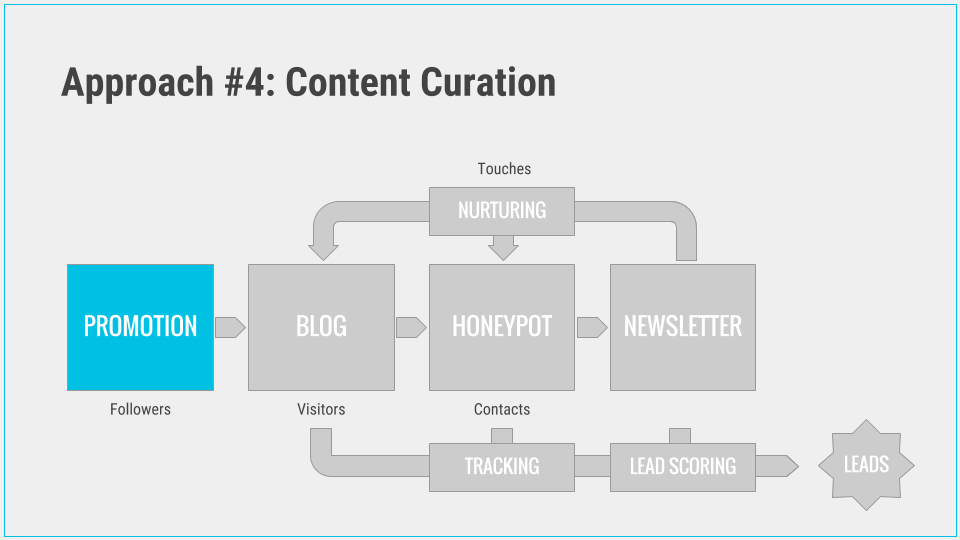
Sometimes the best approach to content marketing is forget content creation for a while and start from “market research”, that is get yourself and team into your domain’s blogs and social media.
The best way to learn the ropes, build social media following, collect ideas and data for your own content and in general learn content marketing in general and in your domain, is content curation.
Content Curation is simply sharing interesting articles to social media.
They say sharing is caring, and it really is. You are actually doing a favor to your audience and adding value. So much new content is created every day, but someone forgot to add more hours so we could read them all. So instead of drinking from a firehose, people prefer to follow people or companies who do the hard work and select the best for them.
While you are doing it, you are learning the content market on your domain pretty well, building relationships with key players, collecting great content or data to use as a reference, learning what formats you can use for your content.
Check out my Ultimate Guide to Content Curation: Getting Starter, Tools, Workflow blog post for more information on the topic.
How long will it take to get started? I flip through 200 blogs daily in the same time it takes me to read newsletter. You’ll need a newsreader app, like Feedly, though. Setting up newsreader takes 10 minutes or so, but if you don't have social media accounts set up, each will realistically take hour to learn the basics and set up. Finding blogs to follow happens over time.
Next step? Promoting your own content, so you need to start blogging.
Now you only need to start
You can start building your inbound marketing operation from any of the four angles. Each will get you early wins, and each is reasonably easy to achieve. However, the whole system starts to pump inbound leads only after all cogs are operative.
It's not a time or resource issue. You can find 2 hours to get started. Stop procrastinating, and just start.
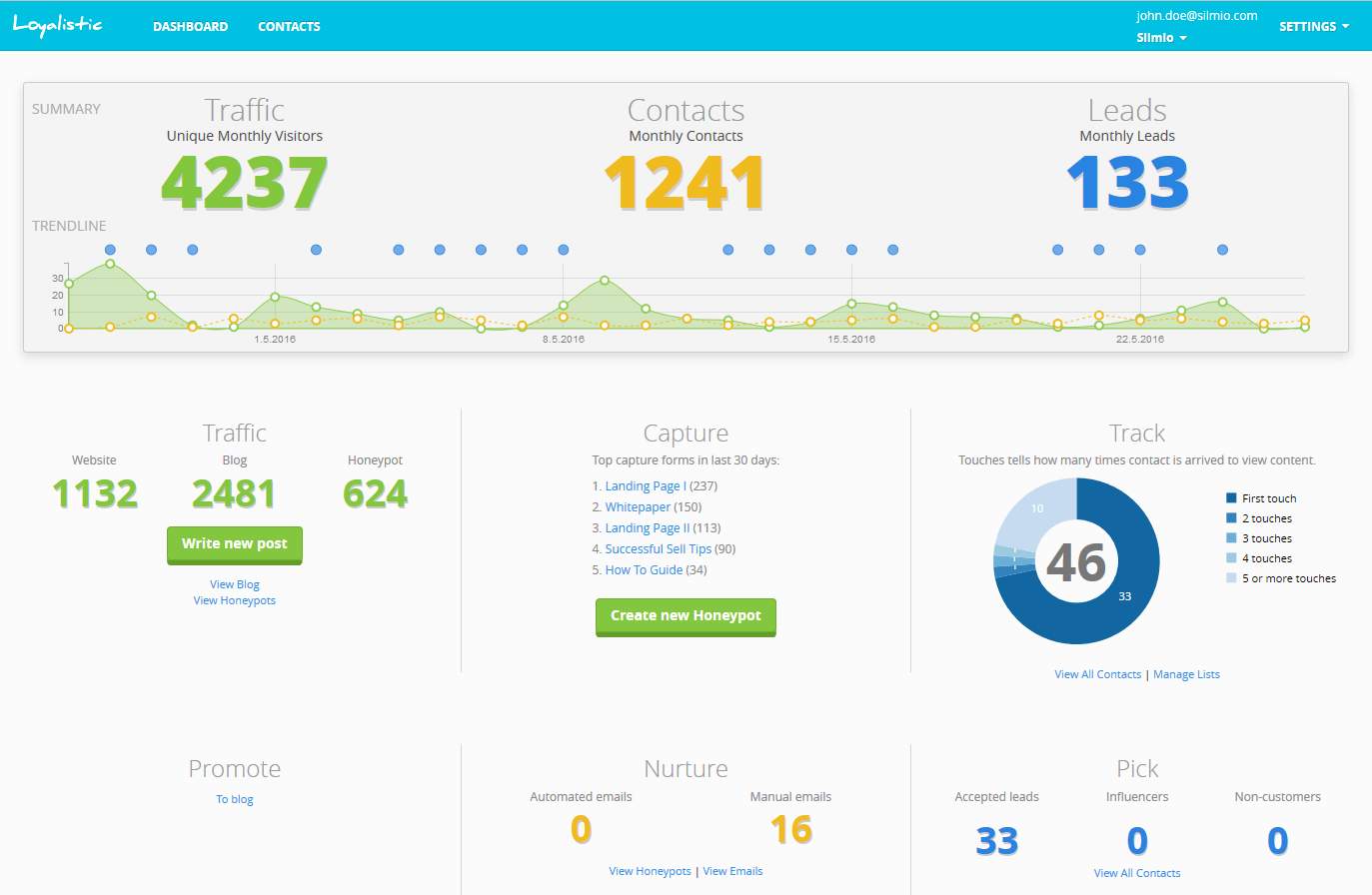
 |
Written by Antti Pietilä Antti is the founder and CEO at Loyalistic (Simple Content Marketing Software for B2B Companies) who loves to help SaaS-companies to grow at Software Entrepreneurs (@ohjelmisto_ry) and cycle. Say hello to him anytime @anttipietila. |
